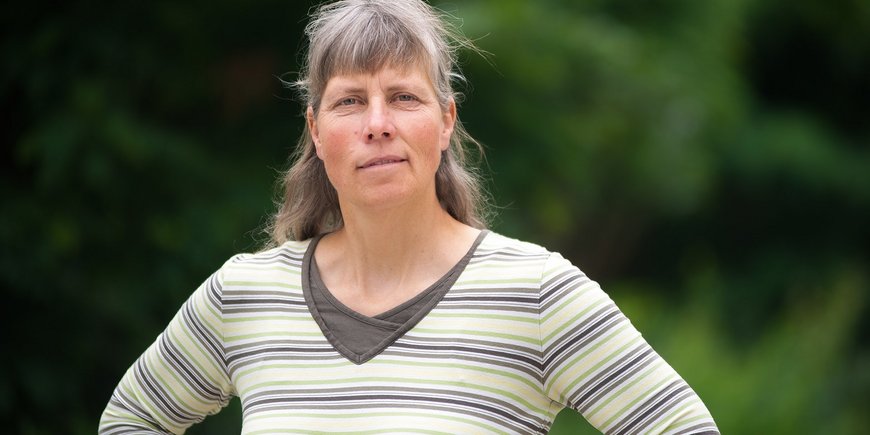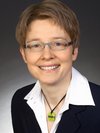Dr Monika Korte, acting head of the GFZ Geomagnetism Section, has been awarded a prestigious ERC Synergy Grant for her GERACLE project. With this grant, the European Research Council ERC is funding particularly ambitious, international research projects involving several teams at the interfaces of established disciplines.
GERACLE stands for ‘Geomagnetic Excursions and Reversals: Establishing their Atmospheric and Climatic Effects’. The aim of the project is to understand the consequences of polarity reversals of the Earth's magnetic field for the atmosphere and our habitat. The Earth's magnetic field provides a natural protective shield against dangerous particles from the solar wind and cosmic radiation. When polarity reversals occur, the field weakens and changes its shape – with sometimes significant consequences for life on Earth. The project is focussing on the entire Sun-Earth system in order to investigate their interactions under unusual magnetic field conditions and a wide range of solar activity and climatic conditions.
The project is coordinated by Monika Korte at the GFZ. It is being carried out together with three teams from Finland and Austria. The project will run for six years, with funding totalling 10 million euros, of which 3.3 million will go to the GFZ. This is another major success for the GFZ at European level in a series of eight ERC grants in the last two years.
Congratulations from Brandenburg's Science Minister Manja Schüle:
“Once again, the European Research Council ERC is honouring the pioneering work at the Potsdam Research Centre for Geosciences with an ERC grant. The interdisciplinary project GERACLE, led by geophysicist Dr Monika Korte, is being honoured for investigating the role of the Earth's magnetic field in the interactions between solar activity and climatic conditions on Earth. I congratulate Dr Korte on this exceptional recognition, which contributes to the international visibility of our science and research location.”
The Scientific Director of the GFZ, Prof Susanne Buiter, also sends her congratulations:
“Congratulations on this outstanding success to Monika Korte and her international team. Their research shows how important it is for the geosciences to consider and understand our Earth in its interaction with the surrounding space. This not only provides fundamental insights into life on Earth that extend from the distant past into the distant future, but is also highly relevant for our technologised society. The fact that the ERC honours this approach is also a confirmation of the GFZ's mission and a success that we celebrate.”
Background: Change and role of the Earth's magnetic field
The Earth's magnetic field acts as a protective shield for our planet against solar wind and cosmic radiation, which determine the so-called space weather. The Earth's magnetic field originates in its liquid outer core and therefore always varies slightly in space and strength. In the course of the Earth's history, however, the magnetic field has also completely reversed polarity several times - permanently or briefly, in the form of so-called excursions or polarity reversals. These extreme field changes are accompanied by a drastic decrease in the magnetic field strength, but also by an increase in the complexity of the field geometry. For example, more than two poles can form. This significantly weakens and changes the protective shield.
The last permanent field reversal, known as the Matuyama-Brunhes, took place 780,000 years ago; the last short-term polarity reversal occurred 41,000 years ago during the so-called Laschamps excursion. However, after around 1500 turbulent years, the magnetic field then returned to its original, comparatively stable polarity. Such events will occur again in the future, even if not in the near future.
The ERC project GERACLE in detail
The ERC project GERACLE investigates the effects of past and future reversals and polarity swings of the Earth's magnetic field on our habitat.
Previous studies, which made simplistic assumptions and analysed correlations rather than the full physical relationships, are inconclusive. They show a broad spectrum of possible effects: from ‘no influence of the field polarity on our habitat’ to strong climatic consequences and the resulting mass extinction of living organisms.
For the first time, GERACLE will comprehensively analyse the complex physical relationships in the entire Sun-Earth system during very different states of the Earth's magnetic field and thus the magnetosphere, but also the Sun and the climate, which is strongly influenced by other factors.
The GERACLE management team is made up of four interdisciplinary members. For the first time, GERACLE brings together expertise on the long-term development of the Earth's magnetic field, the magnetosphere, solar activity and solar-terrestrial relationships as well as radiation processes in the Earth's environment, and on atmospheric processes and Earth system modelling.
Key objectives of the project
“The main goal of GERACLE is to develop a unified physical framework for the Sun-Earth system based on precise palaeomagnetic records. This will allow us to analyse magnetospheric and atmospheric processes under changing geomagnetic field, climate and solar conditions. The results of the project will not only provide information about specific events in the Earth's history, but also important insights into solar-terrestrial relationships under significantly changing geomagnetic fields and the assessment of future space weather hazards. In particular, we want to answer the long-standing question of how serious the effects of geomagnetic reversals and polarity excursions can be on the Earth's environment,’ says GFZ researcher Monika Korte, coordinator of the project.
Organisational matters
In addition to Dr Monika Korte (GFZ), who is in charge of the project, the four-person team also includes Prof Emilia Kilpua (University of Helsinki, Finland), Prof Ilya Usoskin (University of Oulu, Finland) and Prof Harald Rieder (University of Natural Resources and Life Sciences, Vienna, Austria).
The project will run for six years and the total funding amount is 10 million euros, of which 3.3 million will go to the GFZ.
The contributions of the individual partner institutions
The team at the GFZ led by Dr Korte will lead the project. With its many years of expertise in the global reconstruction of past magnetic field development, it will be responsible for the most accurate possible characterisation of the magnetic field during the magnetic field polarity to be investigated. To this end, new palaeomagnetic data from sediment cores will be measured in the laboratory and used together with existing data to calculate global models. Investigations into data quality and possible environmental influences on the magnetic signal play an important role here. The findings will also be used to estimate the magnetic field configuration during a possible future polarity reversal.
The team at the University of Helsinki led by Prof. Kilpua will provide the expertise on solar eruptions, solar wind and radiation belts to the Synergy project. Through GERACLE the researchers expect to achieve several solar physics breakthroughs including a novel understanding of solar and heliospheric structures from grand solar maxima to minimum conditions.
The team at BOKU University led by Prof. Rieder will provide the expertise on chemistry-climate connections and earth-system modeling to the Synergy project. Through GERACLE the researchers expect to provide pioneering insights into changes in atmospheric composition during unusual geomagnetic field conditions and the related consequences for the exposure to elevated UV radiation at the ground, as well as changes in atmospheric circulation and potentially even regional climate.
The team at the University of Oulu led by Prof. Usoskin will provide expertise on the radiation fields in complex magnetospheric conditions during the non-standard geomagnetic configuration. Through GERACLE the researchers expect to achieve several breakthroughs in geophysics, for example, the (non)existence of radiation belts and patterns of the radiation field under unusual geomagnetic field conditions.
About Monika Korte
Dr Monika Korte has long been studying the Earth's geomagnetic core field and its formation. She has been acting head of GFZ Section 2.3 Geomagnetism since 2021. The geophysicist first came to the GFZ in 1997 for her doctoral thesis after graduating from the Ludwig Maximilian University of Munich. She worked at GFZ as a research assistant until 2001 after completing her doctorate at the FU Berlin in 1999. She then conducted postdoctoral research at the Scripps Institution of Oceanography at the University of California in San Diego until 2002 with a Feodor Lynen Fellowship from the Alexander von Humboldt Foundation. Returning to the GFZ, she headed the Niemegk Geomagnetic Observatory from 2003 to 2014, and since 2009 also the Geomagnetic Observatories working group within the Geomagnetism Section. Since 2014, she has been head of the ‘Geomagnetic field evolution’ working group in the same section.
Monika Korte has acquired numerous DFG and other third-party funded projects. In 2003 she received the GFZ Potsdam Research Award. She is active in international committees, including as Vice President of the International Association of Geomagnetism and Aeronomy (IAGA) from 2015 to 2019 and since then IAGA Secretary General.
About the ERC Synergy Grants
The European Research Council (ERC) is an institution set up by the European Commission to fund basic research. The ERC funds excellent scientists and their teams with ground-breaking research projects in various funding lines for the appropriate career stage.
With the ‘Synergy Grants’, the ERC funds teams of two to four outstanding scientists. The projects should lead to discoveries at the interfaces between established disciplines and to substantial progress at the frontiers of knowledge. The projects should be so ambitious that they are only possible through the collaboration of the designated PIs (Principal Investigator). The upper funding limit is around 10 million euros for a maximum duration of 6 years.












![[Translate to English:] [Translate to English:] Abror Gafurov von dem Schriftzug "Welcome to Azerbaijan" und den UN und COP Logos](/fileadmin/_processed_/2/5/csm_2024_11_Baku_COP29_Abror_Gafurov_1042faec82.jpeg)


![[Translate to English:] Martin Herold standing in front of the library on the Telegrafenberg](/fileadmin/_processed_/c/d/csm_Martin_Herold_d385ee4dd9.jpeg)
![[Translate to English:] Many people are listening to a presentation in the GFZ lecture hall.](/fileadmin/_processed_/c/a/csm_1_Bild1_hell_b9c0e9f5ed.jpeg)





![[Translate to English:] Both scientists sitting on stools in front of a wall of books in the Telegrafenberg library](/fileadmin/_processed_/6/6/csm_Buiter_Castell_DORA_4_e87cb1ea18.jpeg)
![[Translate to English:] Gruppenbild mit 4 Personen](/fileadmin/_processed_/8/d/csm_20241017_GFZ-Emmerman-Medal-005_web_reinhardtundsommer_21a414fa4a.jpeg)






![[Translate to English:] Ice landscape with five red tents](/fileadmin/_processed_/8/9/csm_Zeltlager_auf_dem_Eis_Urheberin_Jenine_McCutcheon_5ced2d523b.jpeg)



